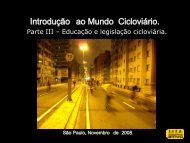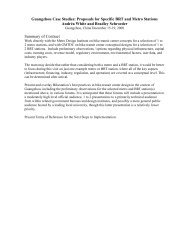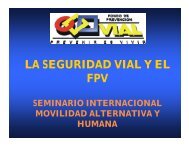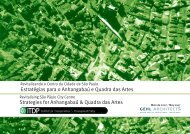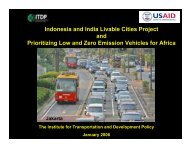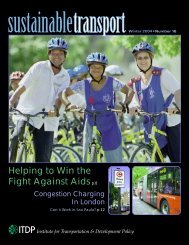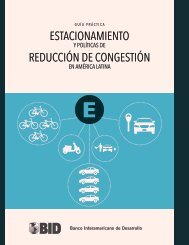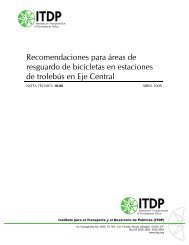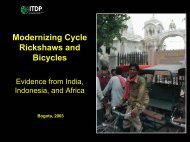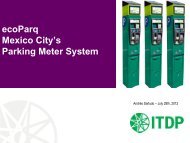Europe's Vibrant New Low Car(bon) Communities - ITDP | Institute ...
Europe's Vibrant New Low Car(bon) Communities - ITDP | Institute ...
Europe's Vibrant New Low Car(bon) Communities - ITDP | Institute ...
Create successful ePaper yourself
Turn your PDF publications into a flip-book with our unique Google optimized e-Paper software.
GWL Terrein 29<br />
Figure 4: Average transport-related emissions of residents<br />
annual transport-related<br />
emissions per resident (kg CO2)<br />
1500<br />
1200<br />
900<br />
600<br />
300<br />
358<br />
899<br />
1311<br />
0<br />
GWL Terrein<br />
(2010)<br />
Amsterdam<br />
(2008)<br />
Netherlands<br />
(2007)<br />
Author’s<br />
elaboration<br />
Figure 5: Importance of various factors on GWL resident decision not to own a car<br />
bike makes car superfluous<br />
public transit makes car superfluous<br />
environmental reasons<br />
healthier lifestyle<br />
too expensive<br />
difficult to find parking near residence<br />
1 2 3 4<br />
not important<br />
very important<br />
<strong>ITDP</strong> Europe, 2010<br />
network of bicycle paths and efficient public transportation system<br />
in the city of Amsterdam allow residents of GWL Terrein to easily<br />
travel to other parts of the city using these modes. When non-carowners<br />
were asked to rank the importance of different factors in their<br />
decision not to own a car, residents gave higher importance ratings<br />
to pull measures such as ease of bicycle and public transport use<br />
and lower importance ratings to push measures such as expense of<br />
owning a car and limited parking (see Figure 5). Also, GWL Terrein’s<br />
location close to the city center has an effect on travel distances<br />
of residents. Therefore, it would appear that a new development<br />
project in a city with a focus on sustainable transportation, especially<br />
located near the center of the city, could have more potential for success<br />
than one located in a car-focused city or far from the city center.<br />
Furthermore, Koepelvereniging, the residents’ umbrella<br />
organization, seems to be an important catalyst for maintaining<br />
resident focus on sustainability, reduced car use and social<br />
interaction. It also gives residents a common source to turn to with<br />
questions or concerns about the development. Such an organization<br />
is recommended for other sites planning to implement a<br />
sustainability-focused community.<br />
sources<br />
Communication with Corine Marseille,<br />
Koepelvereniging organization, May 2010.<br />
Communication with Daniel van Motman,<br />
Department of Traffic Infrastructure and<br />
Transport, City of Amsterdam, May 2010.<br />
Communication with Hans Niepoth, City of<br />
Amsterdam, June 2010.<br />
GVB Website, http://www.gvb.nl (accessed<br />
June 10, 2010).<br />
GWL Terrein Website, http://www.gwl-terrein.<br />
nl/?english (accessed June 10, 2010).<br />
<strong>ITDP</strong> Europe (2010). Interned-based survey of GWL<br />
Terrein residents.<br />
QPark Website, http://www.q-park.nl/tabid/657/<br />
qparkParkingLocatorvw1094/parkingDetail/<br />
ParkingID/613/language/nl-NL/Default.aspx<br />
(accessed June 10, 2010)<br />
Scheurer, Jan (2001). Urban Ecology, Innovations in<br />
Housing Policy and the Future of Cities: Towards<br />
Sustainability in Neighbourhood <strong>Communities</strong>,<br />
Thesis: Murdoch University, Perth Western,<br />
Australia.<br />
Image credits<br />
Figure 1: Koepelvereniging<br />
Photo 1: Koepelvereniging<br />
Photo 2: Peter Elenbaas<br />
Photos 3, 5–10: Nicole Foletta, <strong>ITDP</strong> Europe<br />
Photo 4: Giesbert Nijhuis



